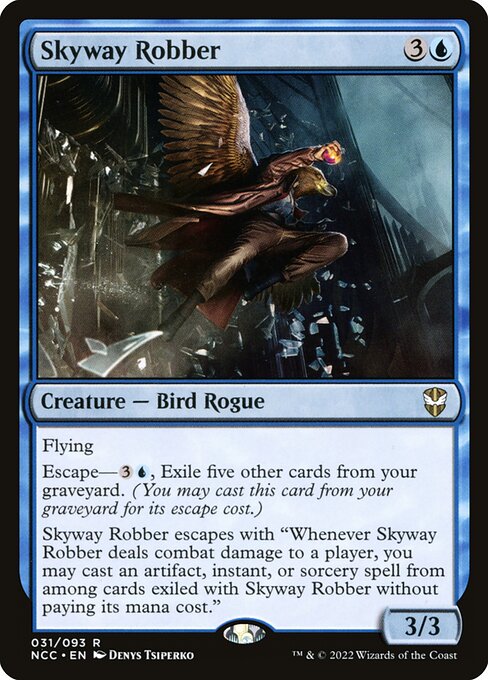
Image courtesy of Scryfall.com
Blue’s Calculated Tempo and the Quiet Weight of Set-Level Balance
Skyway Robber slides into the New Capenna Commander ecosystem as a rare that wears its complexity with pride. For a prudent blue spell-slinger, a 4-mana body with flying is not odd, but the Escape clause and the activated payoff tucked inside its combat trigger push it into a rarer, more deliberate design space 🧙♂️🔥. This is the kind of card that invites set-level analysis: not just “Does it win a game?” but “How does it influence rarity distribution, color balance, and the long arc of the set’s design goals?” In NCC, where blue often threads permission and tempo with graveyard manipulation and artifact interaction, Skyway Robber embodies a measured power budget that rewards skilled piloting and careful deck-building 💎⚔️.
The package in one glance
- Mana cost: {3}{U} for a 3/3 flyer. That’s a solid rate in blue, a color that prizes evasive bodies and tempo advantage.
- Escape: {3}{U}, Exile five other cards from your graveyard. You may cast this card from your graveyard for its escape cost. This is blue-designed resilience—building a recycled engine that scales with games and graveyard activity 🧭.
- Static ability: Flying. A classic blue cavalry of evasive pressure that helps you dump damage while you set up the big plays to come 🪄.
- Triggered payoff: Whenever Skyway Robber deals combat damage to a player, you may cast an artifact, instant, or sorcery spell from among cards exiled with this creature without paying its mana cost. A built-in payoff for successful aggression, especially in longer Commander games where the exile pool can become surprisingly potent ⚔️.
- Rarity and set: Rare in New Capenna Commander (NCC). The card sits at the intersection of high versatility and a manageable power level that blue decks crave, making it a centerpiece for set-level rarity visualization in NCC’s design space 🧙♂️.
Rarity balance in a blue-dominant Commander set
From a design perspective, Skyway Robber’s rarity is telling. A 4-mana 3/3 flier with an escape that refuels your possibilities later in the game is powerful, but not Infinity-powerful. The Escape mechanic requires you to assemble a graveyard pool (exiling five cards) before you unlock the full wizardry of the card in the graveyard, which creates a natural ramp-down in the early game. This helps keep the card from overshadowing bread-and-butter blue cards while still giving late-game payoff that can swing a Commander game into a tense, back-and-forth duel 🧩.
In a set-level visualization, you’d chart rarity distribution by color and by mechanic class. Skyway Robber tends to sit near the sweet spot where blue’s typical play patterns—flying pressure, tempo plays, and graveyard interplay—meet an explicit, engine-driven payoff. The card’s requirement to deal combat damage to trigger the free-cast of an exiled spell ensures that it thrives in a game-state where aggression leads to value, while not collapsing into a one-turn win button. It’s a deliberate calibration: strong enough to matter in late-game scenarios, constrained enough to keep parity with other colors and archetypes. The result is a set that nudges players toward interactive, multi-turn planning rather than single-card wins 🧙♂️🎨.
How this affects gameplay in Commander and beyond
Commander is a format built for persistence, recursion, and synergy. Skyway Robber’s flavor and mechanics align with blue’s long-game storytelling: you invest in the graveyard as a resource, you protect and pressure with a 3/3 flier, and you press for incremental advantage as you exile cards that can later be cast for free. The requirement to exile five cards to enable escape adds a strategic layer: you want to curate a graveyard that accelerates your endgame spells, but you must also protect Skyway Robber while it’s in the battlefield so that you can trigger the damage-based ability reliably 🔥.
When you connect with a player, the reward is not just the nominal tempo; it’s the potential to chain spell-casts from exile. In practical NCC builds, you’ll see artifact and instant/sorcery synergies bloom, particularly around spells that scale with “cast from exile” or that benefit from a recurring graveyard sink. The design encourages players to weave graveyard-exile strategy with blue’s hallmark control elements, creating a layered playstyle where card advantage becomes both tempo and resource management. It’s a compelling example of how a single rare can influence deck-building decisions across an entire set 💎⚔️.
Art, lore, and the tactile thrill
Denys Tsiperko’s illustration gives Skyway Robber a crisp, kinetic vibe that matches the card’s mechanical tempo. The art communicates motion and a hint of urban cunning—the perfect visual metaphor for a Skyway path-walker who thrives in a world of neon crime-capital vibes. The image may not shout flavor text in every print, but the aesthetic sense resonates with NCC’s skyways, chrome, and capstone heists, a reminder that “rarity” in a Commander context also carries collector-appeal and art-value questions that fans eagerly track during set releases 🎨.
Product integration that fits the fan-sphere
As we explore the balance between rarity and power, this is also a moment to celebrate the broader MTG ecosystem—where cross-promotions and real-world products intersect with the tabletop mythos. The featured product link below demonstrates how fans often mix hobby hardware with game-night culture, reminding us that the MTG hobby thrives on the full spectrum of fandom—from card design to everyday accessories 🧙♂️💼.
Product spotlight: Clear Silicone Phone Case Slim Flexible Open Port Design
More from our network
- https://blog.digital-vault.xyz/blog/post/forecasting-mtg-set-design-with-mardu-shadowspear/
- https://blog.digital-vault.xyz/blog/post/jaspera-sentinel-old-flavor-text-meets-modern-mtg-storytelling/
- https://blog.digital-vault.xyz/blog/post/glacial-crasher-creative-mtg-combo-lines-to-freeze-opponents/
- https://blog.digital-vault.xyz/blog/post/practical-guide-to-managing-legacy-codebases/
- https://blog.digital-vault.xyz/blog/post/how-ghostly-pilferer-bends-mtg-meta/